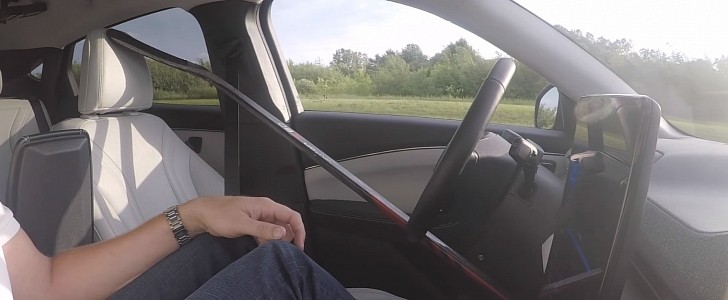Driver assistance systems have become common in the car industry, and they are more advanced than ever. However, that does not mean you can buy a self-driving car today. What happens if you try to trick these systems into driving a car on their own? Well, the results are interesting.
Tesla drivers are considered the worst abusers of the driver assistance technology. Dubbed Autopilot, it has led many to believe that it is a technology capable of driving a car without the person behind the wheel paying attention to the road or even being present behind the wheel. As it turns out, many of these driver assistance systems can be tricked to run as if there is a driver behind the wheel, but we urge you to never attempt this on the road.
Car and Driver went ahead and organized a test with seventeen models from almost all major automakers to find out how each reacts when the driver unbuckles their seatbelt, takes their hands off the wheel, and even what happens when the driver leaves the designated seat.
As you may know, several drivers of Tesla models equipped with Autopilot have done this on the open road, and some of them have shown how they tricked the system into thinking there was a driver at the wheel. The test made by Car and Driver shows that automakers should make these systems smarter regarding checking for driver presence and attentiveness.
Not all driver assistance systems are easy to trick, as some employ a different method to check for driver attention, like BMW and Mercedes, where sensors inside the wheel can sense if it is held. The test proved that those systems can be tricked as well, and each model that was tested did not figure out that the driver had left their seat while the vehicle was driving.
Apparently, the driver's seat weight sensor does not communicate with the driver assistance systems, which meant that simply buckling the seatbelt would allow someone to leave the designated seat for the driver while a vehicle was in motion and with the driver assistance systems activated. The systems that relied on a camera to "see" the driver's eyes can also be fooled.
These systems are designed to be easy to use and make everyday commutes easier for drivers, while car companies are assuming that people would not leave their seats behind the wheel while their car is in motion. These two contradictory situations explain why some systems are so easy to trick – humans are unpredictable, and developing a car meant to counter-act illogical actions has no point.
Unfortunately, people will try to trick these systems so that they can show off online or stop paying attention to the road, but either of those actions is extremely dangerous and can result in a crash. Since highway speeds are involved here, the potential for a fatal crash is high, even with seatbelts buckled correctly.
Car and Driver went ahead and organized a test with seventeen models from almost all major automakers to find out how each reacts when the driver unbuckles their seatbelt, takes their hands off the wheel, and even what happens when the driver leaves the designated seat.
As you may know, several drivers of Tesla models equipped with Autopilot have done this on the open road, and some of them have shown how they tricked the system into thinking there was a driver at the wheel. The test made by Car and Driver shows that automakers should make these systems smarter regarding checking for driver presence and attentiveness.
Not all driver assistance systems are easy to trick, as some employ a different method to check for driver attention, like BMW and Mercedes, where sensors inside the wheel can sense if it is held. The test proved that those systems can be tricked as well, and each model that was tested did not figure out that the driver had left their seat while the vehicle was driving.
Apparently, the driver's seat weight sensor does not communicate with the driver assistance systems, which meant that simply buckling the seatbelt would allow someone to leave the designated seat for the driver while a vehicle was in motion and with the driver assistance systems activated. The systems that relied on a camera to "see" the driver's eyes can also be fooled.
These systems are designed to be easy to use and make everyday commutes easier for drivers, while car companies are assuming that people would not leave their seats behind the wheel while their car is in motion. These two contradictory situations explain why some systems are so easy to trick – humans are unpredictable, and developing a car meant to counter-act illogical actions has no point.
Unfortunately, people will try to trick these systems so that they can show off online or stop paying attention to the road, but either of those actions is extremely dangerous and can result in a crash. Since highway speeds are involved here, the potential for a fatal crash is high, even with seatbelts buckled correctly.














